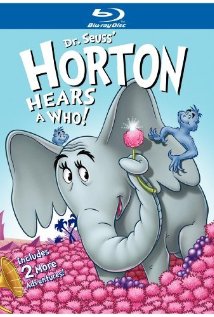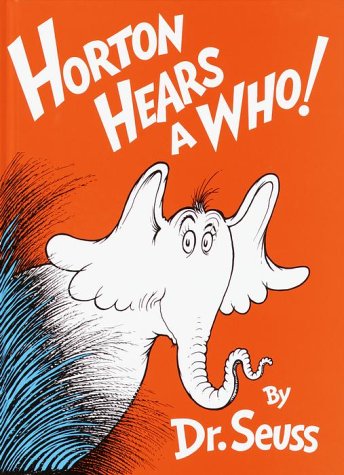Theme Essay by Devin Donovan
Do We Make Too Much Noise?
I had never laid eyes on Horton Hears a Who!, the 1970 television cartoon from Dr. Seuss, before last Christmas. I’d slunk into the family den to escape the usual cocktail chatter, only to find my niece and nephew staring wide-eyed at an elephant carrying around something that looked like a hot-pink dandelion. This dandelion was at the ripe stage of life where almost any child would have to pick it up and blow all the seeds away. My niece and nephew would be no exception. They loved to chop off my head with imaginary lightsabers. Goodbye, dandelion.
But at six and eight, they were still innocent of the adult appetite for small talk, and I knew I’d be safe sitting in the dark with them. As a 31-year-old child, I often sought out the kids’ room for just this reason. We watched the cartoon in happy silence.
Horton the elephant keeps calling the dandelion “clover,” but regardless, it’s where he places the speck of dust that’s the whole world of the Whos down in Whoville. I knew Whoville from How the Grinch Stole Christmas, but I’d never imagined their world to be so tiny. So fragile. The Who speck is jostled about in the sausage fingers of an elephant who, thank Seuss, has a bigger heart and ears than the Grinch. Only Horton can hear the hustle and bustle of the Whos, and with the weight of the species on his shoulders, he bears the microscopic world before him like a dying pet.
For all who know the original 1954 book by Dr. Seuss (aka Theodor Geisel), the TV cartoon short, or the 2008 full-length animated movie with Jim Carrey voicing Horton, it will come as no surprise that Whoville is almost destroyed by other characters who don’t believe the elephant. They can’t see or hear the Whos, so they assume they don’t exist and don’t matter. In Horton Hears a Who!, making noise is what makes a difference, along with caring for those who can’t be heard.
But for me, watching this environmental and spiritual parable unroll for the first time, the obvious metaphor came as a shock. It felt as unfamiliar to me as the neon Seuss galaxy. I found my own thoughts dipping somewhere beyond the uplifting moral of making noise to save precious life—down into my own Grinchy cave.
 The basic plot of the Horton cartoon, which closely follows the original Seuss book, looked very dark from my corner. The survival of Whoville depends on the Whos making themselves known to the rest of the jungle, especially the Grinchy-looking monkeys named the Wickersham Brothers—the local muscle brought in to rope and cage Horton after he’s publicly declared a lunatic for talking to a speck of dust.
The basic plot of the Horton cartoon, which closely follows the original Seuss book, looked very dark from my corner. The survival of Whoville depends on the Whos making themselves known to the rest of the jungle, especially the Grinchy-looking monkeys named the Wickersham Brothers—the local muscle brought in to rope and cage Horton after he’s publicly declared a lunatic for talking to a speck of dust.
The Grinchmonkeys want to destroy the pink dandelion and its speck just because they don’t hear what Horton hears. To disabuse him of his faith, their kangaroo bosses tell them to deep-fry Whoville in “a hot steaming kettle of beezle-nut oil.” (“Boil that dust speck! Boil that dust speck!” the Grinchmonkeys chant.) After it burns, they’ll jerk their thumbs at the shriveled carcass of a world and snarl—as they do in their cartoon song—“There’ll be no more Whos…who are not.”
Shaking off his salty tears, Horton and the mayor of Whoville start planning fast. All the Whos large and tall, all the Whos short and small, are told to make so much noise even the Grinchmonkeys hear them. Some Whos bang drums and flamboozles or trumpet by on complex musical machines worthy of Rube Goldberg. Others scream or sing, and it doesn’t matter what it sounds like; it just has to be loud.
Even so, all this noise is not enough. Even with everyone floot-tooting, the Whos can only be heard by Horton—until the mayor realizes someone hasn't been accounted for: a “small shirker” named Jo-Jo, playing quietly by himself with a yo-yo. The lad is then hustled to the tippiest top of a topply tower and gives a hesitant “yopp.”
With Jo-Jo’s contribution, the Whoville cacophony bursts through the stratosphere of the electric-pink dandelion. The gasses of that planet’s outer space transform random instrument noise, rodent squeaks, and yopps into a unified, coherent articulation of “WE ARE HERE.” Those words float forth repeatedly on the screen.
Miracle! The Grinchmonkeys spare Horton’s dandelion; Horton himself is carried in a jubilant parade through the jungle. And yet, there’s little to indicate the Wickershams and their gossiping bosses won’t go back to weedwacking the billions of other worlds too quiet for even a sensitive elephant to hear.
The cartoon movie ended; the lights came up. My niece and nephew rubbed the trance from their eyes and made their way back to the noise of the party, leaving me in my corner.
It’s a children’s story, of course. It’s also a fairy tale for contemporary humans who know just how fragile the world is. Still, those floot-tooting Whos made me think about our own noise. Maybe we once heard a Horton say, “Hello?,” and then one of us started screaming, “I am here!,” and this hurt the ears of a nearby Grinchhuman, who screamed, “No! I am here!” And the screaming escalated to shooting, exploding, imprisoning, and bombing those who insist on saying “I am here!” instead of listening to those saying they are, too. Maybe this is why we war. It’s the logical end of the first scream. It’s our communal conversation.
We scream because we’re afraid of being silent. Maybe this is all we know. We light gunpowder as if it’s a drum, crash each other’s skulls together like cymbals. We must be machine loud, loud enough for anyone holding the speck of us on a dandelion between his fat, clumsy fingers to hear with his big, stupid ears, confusing our noisy self-destruction for a communal plea for existence. The more yells and explosions and engines and chainsaws, the better.
There is life on this thing, our huge elephant says to the monkeys, listen—and the booms and vrooms and kapows and shrieks of oh my God, why me? all reach his ears, and he says, Such music!—and we shoot spaceships at his eyeballs.
 But Horton can’t hear me. I’m on the dandelion he tramples while looking for his Whos. He’s a good listener, but he won’t save me. He doesn’t even save the Whos; he just transforms them into a noisy clatter. They market themselves for their very survival, forced to scream so loud they can no longer hear themselves or each other.
But Horton can’t hear me. I’m on the dandelion he tramples while looking for his Whos. He’s a good listener, but he won’t save me. He doesn’t even save the Whos; he just transforms them into a noisy clatter. They market themselves for their very survival, forced to scream so loud they can no longer hear themselves or each other.
I’ve never been much of a light show. So, I stand at the edge of the kettle filled with beezle-nut oil and stare into the white-hot void.
In the other room last Christmas, a drunk man’s laughter rattled the ice cubes in his glass. By then, I imagine, he was swimming in scotch, and the volume of his punch line blared its way to every corner of the den, until the space was filled with him.
Eyes shut, he screams into the indifferent darkness, and we reward him for it. He’s so certain of his value. He sees his noise press itself into the flesh of the faces nearest him. I envy his comfort, but bristle at his limited imagination.
Little Jo-Jo knew he was there before he was forced to yopp as proof of his existence. Self-contained in the moment of Whoville’s crisis, delighting in the deep quiet of playing with a yo-yo, he’s labeled a “shirker.” Even with the weight of his world on his tiny shoulders, he hesitates to speak, unsure of his worth. When he does, his yopp is reluctant, reflective, lifesaving.
From my dark corner, I think about my words on a page floating into the neon gasses of outer space. Mine is a silent yopp. I want to be more than a scream. I write down the noise inside me to cultivate my confusion, not to drown it out. My yopp reminds me I’m a Who, a dandelion, an elephant, a Grinchmonkey—a hot-pink speck of dust.
Publishing Information
- Horton Hears a Who! (book) by Theodor Seuss Geisel (Random House, 1954).
- Horton Hears a Who! (TV short) by Theodor Seuss Geisel, directed by Chuck Jones and Ben Washam (The Cat in the Hat Productions/MGM; first broadcast on CBS, 1970).
Art Information
- "Divine Dandelion" © Nicolas Rayond, photomanipulation combining a "macro photo" of a dandelion (courtesy George Hodan, public domain) and an image of the Orion Nebula (courtesy of NASA, ESA, and the Hubble Space Telescope Orion Treasury Project Team); Creative Commons license.
Devin Donovan is a lecturer in composition in the University of Virginia’s writing program.
While pursuing his Ph.D. in English, he ran the Drown Writers Series at Lehigh University in Bethlehem, Pennsylvania. He now lives in Charlottesville, Virginia, with a sweet wife and their devil dog.

